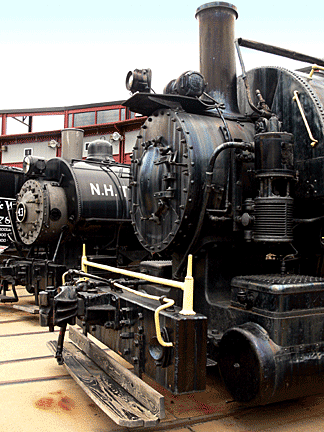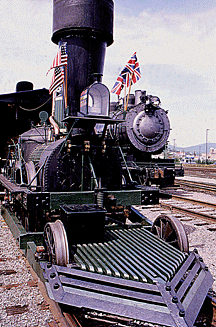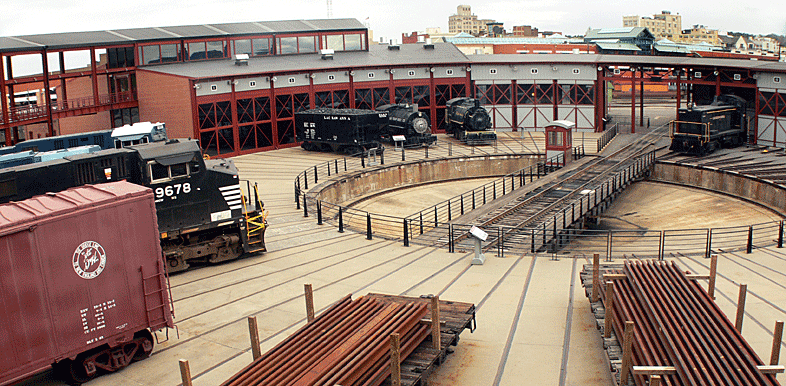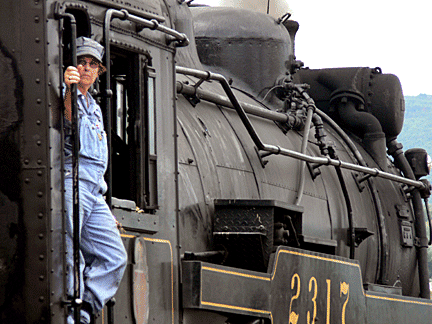|
 The huge steam locomotive chugs into view, its
smokestack billowing clouds of white smoke and steam high into the air. As
it pulls into the station, its bell clanging and a big whoosh coming from
its brakes, a small crowd of men, women and children waits to board the
legendary Phoebe Snow for a nostalgic afternoon excursion from Steamtown
National Historic Site to the town of Moscow, Pennsylvania. The huge steam locomotive chugs into view, its
smokestack billowing clouds of white smoke and steam high into the air. As
it pulls into the station, its bell clanging and a big whoosh coming from
its brakes, a small crowd of men, women and children waits to board the
legendary Phoebe Snow for a nostalgic afternoon excursion from Steamtown
National Historic Site to the town of Moscow, Pennsylvania.
No, Steamtown isn't a place, it's a state of mind that represents all the
railroad towns in the U.S. It's an imaginary place where everyone can forget
the high-tech life of today and remember the romance of the old-fashioned
steam passenger trains. The excursion is only a part of Steamtown. In
addition, it's one of the nation's largest and most famous collections of
steam-era locomotives and other memorabilia.
A millionaire seafood processor, F. Nelson Blount, purchased the
narrow-gauge Edaville Railroad in 1955, having been obsessed with trains
since childhood. Soon after, the Boston and Maine Railroad donated a
locomotive, tender, combine and three coaches and Blount's collection was on
its way.
 By 1960, he had gathered quite a collection and moved it to North
Walpole, New Hampshire. Three years later he established the Steamtown
Foundation for the Preservation of Steam and Railroad Americana and donated
20 locomotives and other pieces of equipment. By 1960, he had gathered quite a collection and moved it to North
Walpole, New Hampshire. Three years later he established the Steamtown
Foundation for the Preservation of Steam and Railroad Americana and donated
20 locomotives and other pieces of equipment.
Nelson Blount was killed in a plane crash in 1965 and by that time, over
50 locomotives had been gathered. The harsh winters were hard on the aging
equipment and the foundation sought another home for the collection.
Scranton was selected and the first excursion was run in the Fall of 1984.
Over 40,000 people turned out in the next eight weeks and Steamtown was on
its way.
Examples of the collection are on display in the railyard. Visitors are
able to climb up onto the Union Pacific's "Big boy," the world's
largest steam locomotive, weighing over 1.2 million pounds and stretching
more than 130 feet in length. There are also handcars, a railway post car,
and the "Prince of Liege," a locomotive built in Belgium in 1877
and the oldest in the collection.

 It's appropriate that Scranton was chosen for Steamtown, for it was here
that the steam age was born. While iron furnaces produced the first T-rails,
North America's first locomotive tugged coal from Lackawanna County to
market. Also, Scranton contained an industrial complex which, over the
years, produced more than a thousand of the nation's earliest steam
locomotives. It's appropriate that Scranton was chosen for Steamtown, for it was here
that the steam age was born. While iron furnaces produced the first T-rails,
North America's first locomotive tugged coal from Lackawanna County to
market. Also, Scranton contained an industrial complex which, over the
years, produced more than a thousand of the nation's earliest steam
locomotives.
Every summer, a continuous stream of railroad fans travel through the
portals of time to the glory days of yesteryear when steam was king and the
nation was linked by a web of rails. They climb into the cab of a vintage
locomotive, sort mail in a railway post office car, sit down in the train's
office—the caboose—imagine what it's like to drive a steam locomotive.
Afterwards, they view historic photographs of the railyard in action in the
new museum or join a ranger on an interpretive walk through the railyard and
roundhouse.
The restoration shop is actively repairing and preserving rolling stock
with a heritage in various railroads. A history museum and technology museum
tell of the advances in railroading safety features brought about with the
help of the labor unions and the various jobs to be found on the railroad.

 Interpretation here takes on a more human side. National Park personnel
have accumulated scores of interviews with living railroaders to help them
tell the story of steam. A new 30-minute film, based on these interviews,
will be shown for the first time this summer in the new 250-seat Steamtown
theater adjacent to the museum. A bookstore has been installed in the former
oil house, where a display shows the machinery used to extract oil from the
engines. Interpretation here takes on a more human side. National Park personnel
have accumulated scores of interviews with living railroaders to help them
tell the story of steam. A new 30-minute film, based on these interviews,
will be shown for the first time this summer in the new 250-seat Steamtown
theater adjacent to the museum. A bookstore has been installed in the former
oil house, where a display shows the machinery used to extract oil from the
engines.
Steamtown is dedicated to preserving the culture of railroading during
the steam years. This National Historic Site contains a working roundhouse,
with three operating locomotives. A vast locomotive shop complex allows
plenty of space for repairs to the iron horses of yesterday.
A excursion to the
town of Lackawaxen is of particular interest to rail fans
because it crosses three of the most famous railroad bridges in the
nation, including the Tunkhannock Viaduct, the largest concrete arch span in
the world, in the village of Nicholson, Pennsylvania, and the Marten Creek
Viaduct, a few miles to the north in Kingsley, Pennsylvania. The third
bridge, the Starrucca Viaduct, in Lanesboro was built out of blue stone in
1848.
This article first appeared in The New York Post.
<
Back to
History Articles
Go to next History article > |
